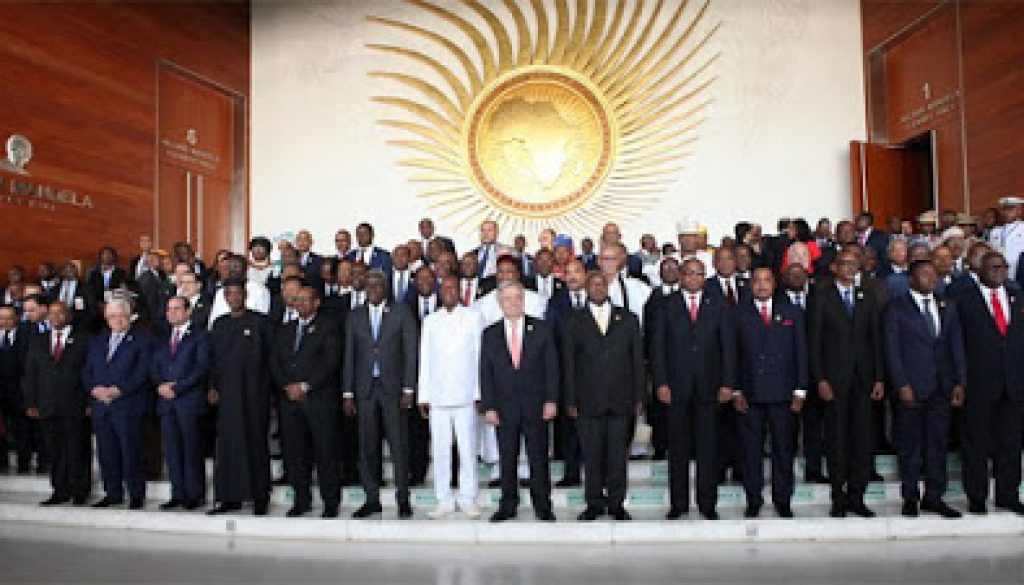The Road to Continental Free Trade Area (1)
Recently President Buhari of Nigeria gave the
countries weight to the establishment of CFTA. Coming from the President of the
most populous countries in Africa at this time, five (5) years after that was
agreed in AU suggest a lot of intricacies. We should recall that it was in their
50th Anniversary Solemn Declaration, the heads of State and
Government of the African Union (AU), while acknowledging past successes and
challenges, rededicated themselves to the continent’s accelerated development
and technological progress. They laid down vision and eight ideals to serve as
pillars for the continent in the foreseeable future, which Agenda 2063 will
translate into concrete objectives, milestones, goals, targets and
actions/measures Agenda 2063 strives to enable Africa remain focused and
committed to the ideals envisaged in the context of a rapidly changing world.
countries weight to the establishment of CFTA. Coming from the President of the
most populous countries in Africa at this time, five (5) years after that was
agreed in AU suggest a lot of intricacies. We should recall that it was in their
50th Anniversary Solemn Declaration, the heads of State and
Government of the African Union (AU), while acknowledging past successes and
challenges, rededicated themselves to the continent’s accelerated development
and technological progress. They laid down vision and eight ideals to serve as
pillars for the continent in the foreseeable future, which Agenda 2063 will
translate into concrete objectives, milestones, goals, targets and
actions/measures Agenda 2063 strives to enable Africa remain focused and
committed to the ideals envisaged in the context of a rapidly changing world.
Agenda 2063 is both a Vision and an Action Plan. It
is a call for action to all segments of African society to work together to
build a prosperous and united Africa based on shared values and a common
destiny. All policies and strategies employable must be employed by the line
Department (DTI) to realize this vision. Our medium have not established
discussion with DTI-AUC on their actions so far.
is a call for action to all segments of African society to work together to
build a prosperous and united Africa based on shared values and a common
destiny. All policies and strategies employable must be employed by the line
Department (DTI) to realize this vision. Our medium have not established
discussion with DTI-AUC on their actions so far.
In a related development the 18th
Ordinary Session of the Assembly of Heads of State and Government of the
African Union, held in Addis Ababa, Ethiopia in January 2012, adopted a
decision to establish a Continental Free Trade Area (CFTA) by an indicative
date of 2017. The summit also endorsed the Action Plan on Boosting Intra-Africa
Trade (BIAT) which identifies seven clusters: trade policy, trade facilitation,
productive capacity, trade related infrastructure, trade finance, trade
information, and factor market integration. The CFTA will bring together
fifty-four African Countries with a combined population of more than one
billion people and a combined gross domestic product of more than US $3.4
trillion.
Ordinary Session of the Assembly of Heads of State and Government of the
African Union, held in Addis Ababa, Ethiopia in January 2012, adopted a
decision to establish a Continental Free Trade Area (CFTA) by an indicative
date of 2017. The summit also endorsed the Action Plan on Boosting Intra-Africa
Trade (BIAT) which identifies seven clusters: trade policy, trade facilitation,
productive capacity, trade related infrastructure, trade finance, trade
information, and factor market integration. The CFTA will bring together
fifty-four African Countries with a combined population of more than one
billion people and a combined gross domestic product of more than US $3.4
trillion.
Negotiations for the CFTA were expected to take
place from 2015-2016 and the CFTA should be launched by an indicative date of
2017. The main objectives of the CFTA are to create a single continental market
for goods and services, with the free movement of business persons and
investments, and thus pave the way for accelerating the establishment of the
Customs Union. It was also expected to expand intra-African trade through
better harmonization and coordination of trade liberalization and facilitation
and instruments across the RECs and across Africa in general. The CFTA is also
expected to enhance competitiveness at the industry and enterprise level
through exploitation of opportunities for scale production, continental market
access and better reallocation of resources.
place from 2015-2016 and the CFTA should be launched by an indicative date of
2017. The main objectives of the CFTA are to create a single continental market
for goods and services, with the free movement of business persons and
investments, and thus pave the way for accelerating the establishment of the
Customs Union. It was also expected to expand intra-African trade through
better harmonization and coordination of trade liberalization and facilitation
and instruments across the RECs and across Africa in general. The CFTA is also
expected to enhance competitiveness at the industry and enterprise level
through exploitation of opportunities for scale production, continental market
access and better reallocation of resources.
According to the World Trade Oragnisation (WTO) the
level of intra- African trade in 2012 was 12.8% which is very low compared to
other regions in the world. The share of Africa’s total exports in global trade
flows was 3.5% which is extremely low compared to other regions. An African
exporter faces an average non-agriculture applied tariff protection rate of
7.8% which is higher than what the same exporter would face when exporting to
Europe and the United States. Trade among Africa’s economies which do not
belong to the same Regional Economic Community is on the basis of the most
favored nation principle. This commercial reality of cross border trade in
Africa simply demands that more should be done in order to come up with
framework that provides for the reduction of tariffs, elimination of non-tariff
barriers and a rule based mechanism for contract enforcement and dispute
settlement among other things. The CFTA provides such a framework and is in
line with the goal of the Abuja Treaty Establishing the African Economic
Community.
level of intra- African trade in 2012 was 12.8% which is very low compared to
other regions in the world. The share of Africa’s total exports in global trade
flows was 3.5% which is extremely low compared to other regions. An African
exporter faces an average non-agriculture applied tariff protection rate of
7.8% which is higher than what the same exporter would face when exporting to
Europe and the United States. Trade among Africa’s economies which do not
belong to the same Regional Economic Community is on the basis of the most
favored nation principle. This commercial reality of cross border trade in
Africa simply demands that more should be done in order to come up with
framework that provides for the reduction of tariffs, elimination of non-tariff
barriers and a rule based mechanism for contract enforcement and dispute
settlement among other things. The CFTA provides such a framework and is in
line with the goal of the Abuja Treaty Establishing the African Economic
Community.
In line with the a strategic objectives of the
Unions Agenda 2063 initiative, the CFTA provides a lever that can be used to
strategically position the continent to exploit its numerous trade and
investment opportunities and contribute positively towards the structural
transformation of African economies. In the process of transforming Africa, the
CFTA should contribute towards the creation of decent and gainful employment
opportunities for African citizens. Overall trade among African countries
should contribute towards poverty eradication and have a positive impact on the
lives of the citizens.
Unions Agenda 2063 initiative, the CFTA provides a lever that can be used to
strategically position the continent to exploit its numerous trade and
investment opportunities and contribute positively towards the structural
transformation of African economies. In the process of transforming Africa, the
CFTA should contribute towards the creation of decent and gainful employment
opportunities for African citizens. Overall trade among African countries
should contribute towards poverty eradication and have a positive impact on the
lives of the citizens.
The move to establish the CFTA comes at a time when
seven of the world’s ten fastest growing countries are in African and the
continent also has a fast-growing middle class. Indeed, a lot of positive
developments are happening across the continent and Africa is on the rise. It
is therefore imperative that the CFTA was designed in such a way that it
provides an opportunity to integrate the fragmented national markets into a
functional continental market. Yet, pursuing market integration and leaving out
important aspects such as trade facilitation, infrastructure and industrial
capacity development will not yield the required results. African member states
that implement the right policy mix should be able to take advantage of the
trade and investment opportunities brought about by the growth that the
continent is currently enjoying.
seven of the world’s ten fastest growing countries are in African and the
continent also has a fast-growing middle class. Indeed, a lot of positive
developments are happening across the continent and Africa is on the rise. It
is therefore imperative that the CFTA was designed in such a way that it
provides an opportunity to integrate the fragmented national markets into a
functional continental market. Yet, pursuing market integration and leaving out
important aspects such as trade facilitation, infrastructure and industrial
capacity development will not yield the required results. African member states
that implement the right policy mix should be able to take advantage of the
trade and investment opportunities brought about by the growth that the
continent is currently enjoying.




